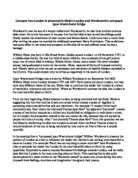Many poor children had to work in factories making cloth or household goods. It was very dangerous in the factories for children, especially when they had to go underneath the machines and pick up the waste material. They often worked twelve hours a day, among machines that were deafening and fast-moving. One job children had was as "piecers", repairing broken thread in cotton mills. Many became ill or had bad accidents, which left them with injuries. Factory and mine owners did not think that anything was wrong with children doing nasty jobs. They were paid very little money there were no laws to protect them. Small boys also did chimney sweeping for rich people, they worked as slaves for a master sweep, who forced them up the chimneys. Sometimes they got stuck up there and died of suffocation, or would become ill because of the soot that would enter the boy’s lungs.
William Wordsworth thinks London is a happy place where the sun is always shining. He was did not seem aware of the poorer more dreary side of London. He likes London more in the morning because he describes its beauty in the morning only. He mentions that London was a majestic place which may refer to the fact that London is a very royal city. He mentions all the leisure aspects of London like the ships, towers, domes and theaters which refer to London as being a wealthy and a fun place. William Wordsworth must of thought that London was full of nature and beauty, with lovely rivers and steep hills. He talks about the house’s being asleep and of calm.
William Blake has a very negative view of London. He sees the reality of the poor and run down areas, so he has a more realistic view on London. He mentions all the dreary but true points of London. He thinks London is a place full of fear. He sees all the harlots and what pain they are going through. He feels for the poor and the hardship they are going through. He thinks that London is not a very comfortable place to live in, that there is a lot of commotion and disruption in most area’s that he passes. He feels that London is a place where unwanted babies are born and are also dieing because of diseases being past through the mother to the baby. He thinks London is a place where poor people are dieing because they can’t afford medical treatment.
William Wordsworth describes the sun rising as beautiful since it is in the morning. He describes the morning as if it is like heaven with words such as “bright and glittering”. He says the air is “smokeless” which obviously would be in the morning since the factories are not running, but during the noon and after it is full of smoke because of the factories. He uses personification by describing the river as if it was alive. This would make William Wordsworth feel like he is in wonderland or in his own world. It would make him feel more relaxed and calm.
When you compare the two poems, their moods are completely different. William Wordsworth’s poem has a more positive view compared to William Blake’s. Blake’s poem is more sullen with a feeling of hopelessness to it. There is a dark feeling about his poem. Where as Wordsworth has a brighter outlook on London. Wordsworth’s poem is an optimistic view; there is a sense of beauty, calm and godliness.
Out of the two poems I prefer Blake’s poem. His poem is more down to earth, he has taken time to look at the reality of everyday lives of people from poorer backgrounds. Yet he recognizes that there are riches in London by mentioning the walls of the palace. His poem is more realistic then Wordsworths. He does not just go on about one thing he writes about different difficulties of people in London. I don’t like William Wordsworth’s poem that much because it is a bit boring and its like as if he is describing a picture instead of London.
William Blake uses repetition in the second verse with “every”. This poem is written in verses. “Mind forg’d manacle” is a metaphor. “Runs in blood down palace walls” is also a metaphor it creates an image in your head of blood running down palace walls and it means that it’s the royalties fault for all the soldiers because their sending them to war. The rhyme in Blake’s poem is a,b,a,b,c,d,c,d,e,f,e,f,g,h,g,h,d,i,d,i.
William Wordsworth’s poem is a sonnet (it contains fourteen lines). The rhythm of the sonnet expresses love. The rhyming pattern is always changing. He uses repetition with the word “never”. “The city now doth like a garment wear” is a simile an is also personification he gives the city a human characteristic. The sun is personified by using the word “his”. “The river glideth at its own sweet will” is also personification; it’s describing the river as if it flows as it wants.







